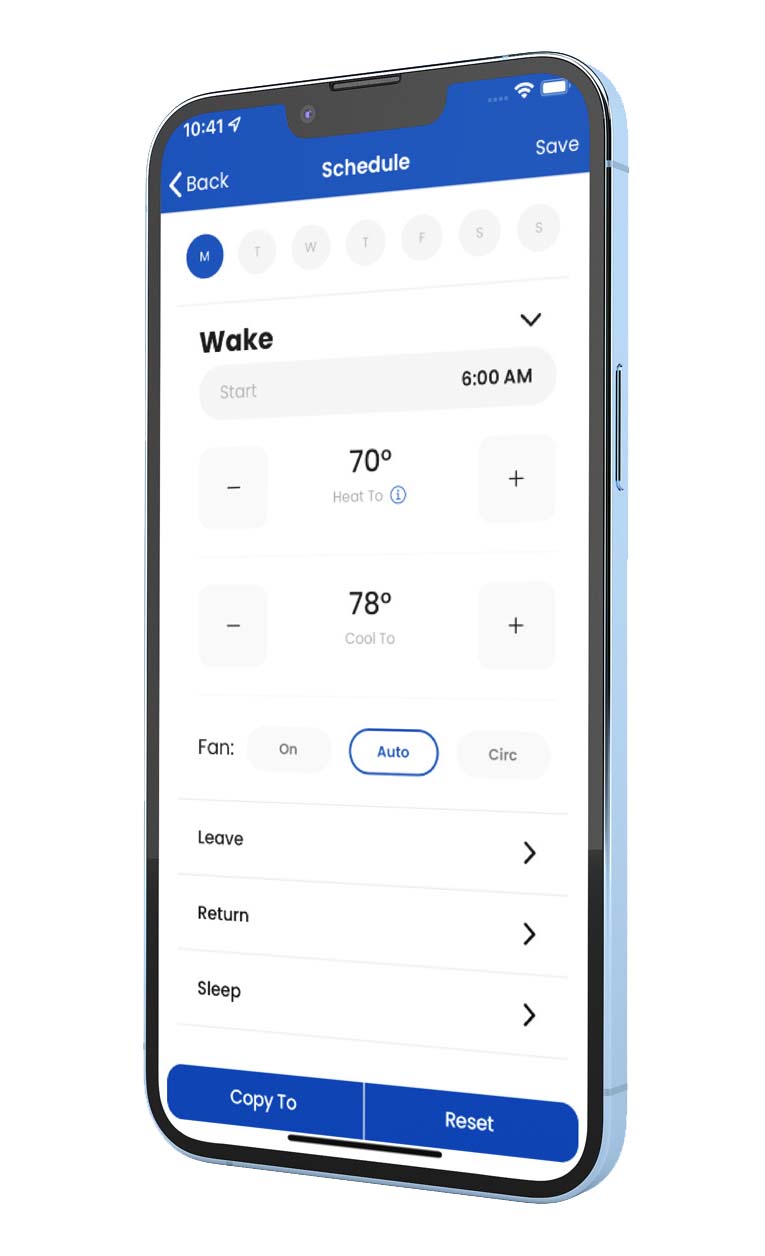It has now been two years since the pandemic brought indoor air quality to the forefront of everyone’s minds. Today, building operators of all kinds of facilities, from offices to hotels, promote the steps taken to ensure safe indoor air. Manufacturers are stepping up with an array of products to clean and monitor the air people breathe.
The pandemic made Americans realize that they spend almost 90% of their time on average indoors. At the same time, consumers developed increased concern about environmental factors such as wildfire. These factors point toward continuing demand for IAQ products.
“Massive consumer awareness is driving significant IAQ demand,” said Jerad Adams, director of commercial product management at Friedrich Air Conditioning Co. “It seems that all IAQ technologies are currently selling extremely well, as everybody seeks sustainable healthy air solutions.”

MORE CONTROL: The AprilAire Healthy Air app allows consumers to control various IAQ devices in their homes. Consumers want more control over their indoor environment, and they want assurance that they are getting what is promised. (Courtesy of AprilAire)
Consumers continue to seek ways to improve the air they breathe at home, said Brandon Glancy, national sales trainer for AprilAire. At the same time, they want peace of mind as the return to their offices and start going out again. Both these trends benefit IAQ.
“The pandemic got a lot of people thinking more about the quality of the air in and out of their homes,” Glancy said. “There’s a real focus on things like proper ventilation, humidity, and air filtration.
“There’s a big appetite for those aspects of life to return to normal,”
Filtration, Ventilation, Humidity
People used to focus only on comfortable indoor temperature and humidity when considering an HVAC system, said Sankar Padhmanabhan, global application expert of packaged systems at Danfoss. Now they focus on both thermal comfort and mitigating airborne health risks. Ventilation, filtration, and longer equipment operation (via modulation) are now critical in IAQ, Padhmanabhan said.
Requirements of filtration have increased across the board, Adams said, and new and existing IAQ technologies have been pushed to the forefront. These technologies include bipolar Ionization and UV-C lighting, along with effective make-up air capabilities. While MERV 13 and HEPA filters remain critical recommendations in improving indoor air, Friedrich has moved beyond single-source technology for the delivery of clean indoor air. The company now offers an entire line dedicated to IAQ — the FreshAire IAQ initiative, with factory certified or OEM-branded IAQ room a/c solutions. These solutions incorporate ASHRAE-recommended protocol to address IAQ and airborne transmissions.
Not every approach to improving IAQ has worked, and some solutions improve IAQ but bring other costs. Bringing outdoor air through conventional rooftop or air handling systems has been the common approach for ventilation, Padhmanabhan said, but this has not improved IAQ or energy efficiency.
What Works
As buildings become more leak-proof, it is necessary to separate the handling of ventilation air and recirculated air, Padhmanabhan said. From an energy efficiency perspective, variable-speed technology, both in compression and air flow, is a proven technology in ventilation applications.
Heat recovery is another topic that needs more focus when it comes to bringing in outdoor air, Padhmanabhan said. He also said microchannel heat exchanger technology is vital in DOAS units.
“Using microchannel heat exchangers as condensers and to reheat coils gives a boost in latent capacity and efficiency and reduces in refrigerant charge,” Padhmanabhan said.
Although people are more aware of IAQ than ever before, they want reassurance that the solutions chosen by either them or the building operator are working, Glancy said. This means they want more monitoring. AprilAire recently entered a formal partnership with Airthings, a company that provides the ability to do just that.
Airthings will integrate its flagship air quality monitor, View Plus, into AprilAire’s IAQ products. View Plus monitors seven air quality components in homes, including particulate matter, CO2, and radon. HVAC contractors can remotely monitor air quality in the homes they service while also providing full air quality visibility to the homeowners themselves.
Beyond Pandemic Concerns
AprilAire also recently added radon mitigation systems to its portfolio. Glancy said this is the kind of IAQ issue people will pay more attention to now that their awareness has been heightened. Radon is the No. 1 cause of lung cancer among non-smokers, he noted.
“People are just more in touch with what indoor air quality products can do to benefit them, keep them healthy, keep their families safe,” Glancy said.
The increased attention to IAQ makes it more important than ever that HVAC contractors can offer up-to-date advice to their customers. Manufacturers are working to provide them with the information they need. Danfoss is hosting a virtual conference on March 16 that will address several key technologies, including IAQ. AprilAire regularly updates it website and has a dedicated in-house customer service team for IAQ.
“Through that, we’ll all get better at communication, and we will solve more homeowners’ needs more quickly, which is something they desire and something that our industry, more than anyone, is capable of doing,” Glancy said. “Homeowners rely on a contractor’s expertise. They want to full understand what’s going on and what’s going into their home and how it’s going to benefit them.”
Friedrich’s Adams expects industry organizations like AHRI, HARDI, ACCA, and ASHRAE will continue to support testing and evaluation and make data-driven technology recommendations. More academic studies and recommendations are also adding to the conversation. Padhmanabhan said there have also been recommendations from bodies such as the World Health Organization.



Report Abusive Comment